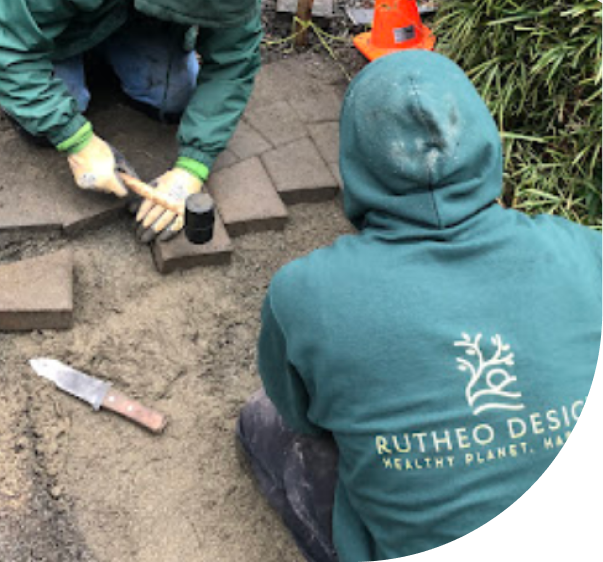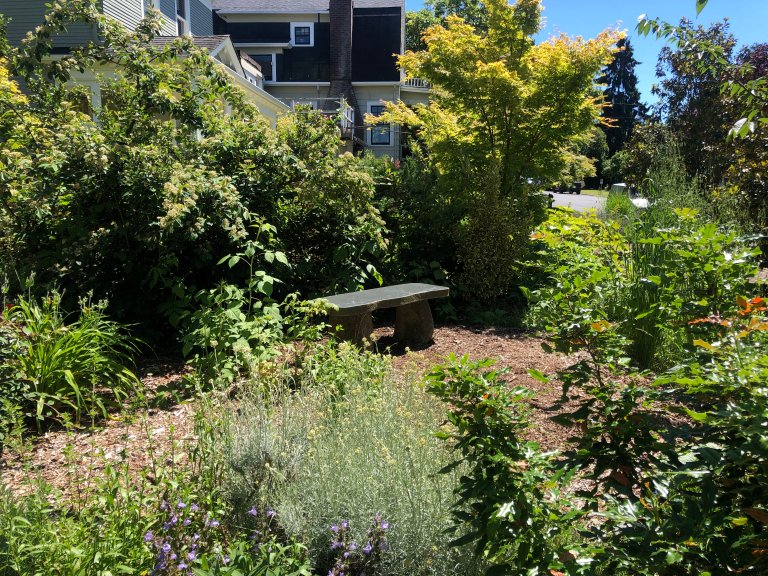
At Rutheo Designs, we transform residential and community spaces into thriving food forests—layered ecosystems that produce food, build soil, and support biodiversity year-round. Inspired by natural forest structure, we design with canopy trees, berry shrubs, herbs, groundcovers, root crops, and vines, all arranged in resilient plant guilds.
Tailored to Seattle’s climate, each project begins with a thorough site analysis and phased planning for long-term success. We integrate elements like rainwater harvesting, wildlife-friendly borders, and soil-building practices to create low-maintenance, regenerative systems. Whether for urban lots or rural land, our food forests nourish both people and place.
A food forest is a type of edible landscape modeled after a natural woodland ecosystem. Rather than rows of single crops, it features multiple layers of plants working together to form a stable, productive system. These layers mimic the structure of a healthy forest and include trees, shrubs, herbs, vines, groundcovers, and root crops. This polyculture approach builds natural resilience, minimizes pest pressure, and eliminates the need for external inputs like synthetic fertilizers. In a food forest, nutrient cycling happens through plant debris, root systems, and soil life, forming a self-sustaining ecosystem over time.
At the core of this design is diversity. We group compatible plants together into “guilds” that support each other’s growth through dynamic accumulation, nitrogen fixing, pollination, and pest deterrence. This interconnected design not only yields food but also improves soil health, retains moisture, and supports beneficial insect populations. A food forest is more than just a productive landscape—it’s a living system that evolves, regenerates, and strengthens itself as it matures.
Unlike annual vegetable gardens that require replanting, tilling, and regular inputs, food forests emphasize perennial species and passive management. Their structure focuses on long-term productivity, with fruit trees and perennial herbs forming the backbone of the system. Where a conventional garden might rely on fertilizers and irrigation, a well-designed food forest maintains fertility through layered mulch, deep root systems, and moisture-holding groundcover.
The goal is to shift from a high-labor, high-input model to one that becomes increasingly self-regulating. Instead of replacing plants each season, we let plants grow into their niches, building canopy and soil life at the same time. Over time, a food forest becomes less dependent on human maintenance and more capable of supporting itself naturally.
Seattle’s climate is well-suited for food forest systems thanks to its moderate rainfall, long growing season, and forest-friendly conditions. Our designs embrace the region’s wet winters and dry summers by building in passive water retention features like swales and mulched basins. We work with native and climate-adapted plants that thrive in forest edge conditions, where filtered light and rich soils mimic natural succession patterns.
Designing for Seattle also means understanding fungal-dominant soil systems, common to the Pacific Northwest. We avoid tilling and use decomposing woody materials, leaf litter, and fungal inoculants to build soil health. This local ecological context influences everything from plant selection to maintenance strategies, allowing us to design food forests that truly belong in their environment.
A food forest is designed with multiple vertical layers that optimize space, light, and ecological interaction.
Guilds are groupings of plants that work together to perform multiple functions around a central plant, often a tree. For example, an apple tree guild might include comfrey to mine nutrients, clover to fix nitrogen, garlic to repel pests, and bee balm to attract pollinators. These companion systems reduce maintenance and increase resilience by leveraging natural plant relationships.
Guild design considers root depth, bloom time, nutrient needs, and habitat value, ensuring that all parts of the guild support the ecosystem without competition or redundancy.
We focus on building fungal-dominant, carbon-rich soil that supports perennial plant communities. This includes avoiding soil disturbance, layering organic matter through chop-and-drop mulching, and incorporating woody debris. Fungi play a key role in connecting plant roots through mycorrhizal networks that transport water and nutrients while protecting against disease.
Our designs favor systems that build soil rather than deplete it. Over time, these techniques create a living soil web that enhances fertility, supports biodiversity, and makes the whole system more drought-tolerant and productive.
Our design process starts with an in-depth site visit or remote consultation, followed by soil testing, sun mapping, and layout planning. We work closely with clients to develop a phased plan tailored to their land use goals, lifestyle, and timeline. Initial steps may include infrastructure setup, water management, and planting of key structural species.
Each implementation is guided by ecological design principles that prioritize soil health, long-term productivity, and client involvement. Whether you’re building a backyard orchard or a multi-acre food system, our team ensures that every phase aligns with natural cycles and local conditions.
Not every client wants—or needs—a full installation from day one. We offer modular planning and DIY support for those who want to install their forest in stages. From layout sketches to plant selection guidance, we provide as much or as little involvement as needed.
Families, schools, and community groups often benefit from this phased approach. It allows for education, adaptation, and greater community engagement with the land over time. We help clients track progress and adjust plans as the system grows.
Food forests don’t exist in isolation. They’re most powerful when integrated into the larger ecological vision of a property. We connect food forests with existing rain gardens, native meadows, and habitat zones to create seamless transitions across the landscape.
This integration enhances functionality and aesthetic value while supporting broader sustainability goals—like stormwater management, pollinator habitat, and carbon sequestration. Whether placed near a patio, tucked along a woodland edge, or flowing into an edible meadow, food forests are a living investment in both abundance and ecological health.

At Rutheo Designs, we are dedicated to transforming your outdoor spaces into beautiful, sustainable landscapes that reflect your vision and the unique character of the Seattle area. Whether you’re looking to enhance your garden with native plants, need expert advice on water-efficient irrigation systems, want to explore custom hardscaping for your outdoor living space, or discuss a comprehensive landscape design, our team is here to assist you every step of the way. We offer services in native plant landscaping, water-efficient irrigation, custom landscape design, and hardscaping solutions tailored to your goals and the local environment. Every project is unique, and we take the time to listen to your needs and offer personalized solutions that align with both your aspirations and Seattle’s natural surroundings.
We invite you to reach out to us to start the conversation about your landscaping needs. You can contact us by email at connect@rutheodesigns.com or give us a call at (360) 844-2989. Whether you have specific questions or are ready to schedule a consultation, we’re eager to help you bring your outdoor vision to life with the care and expertise that Rutheo Designs is known for.